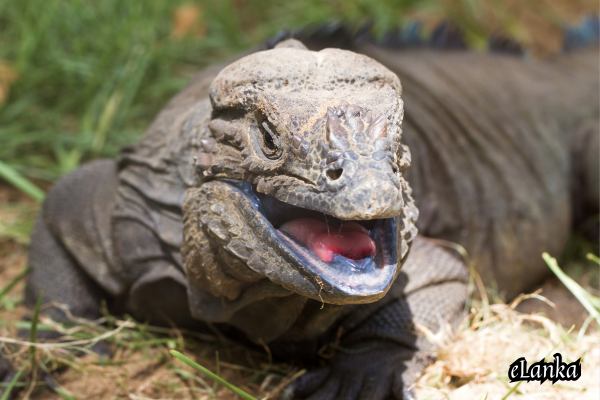Thalagoya: The Fascinating Sri Lankan Monitor Lizard- By Bhanuka – eLanka

The Thalagoya, commonly known as the Sri Lankan Monitor Lizard, holds a unique place in Sri Lanka’s ecosystem, culture, and folklore. Known scientifically as Varanus bengalensis, this species is a member of the monitor lizard family, a group of reptiles renowned for their size, intelligence, and adaptability. In Sri Lanka, the Thalagoya is both admired and misunderstood, making it a creature of intrigue and significance.
In this article, we will explore the biology, habitat, behavior, cultural significance, and conservation of the Thalagoya in Sri Lanka.
Physical Characteristics of the Thalagoya
The Thalagoya, also referred to as the Bengal Monitor, is a medium to large-sized lizard. Key physical features include:
- Size: Adult Thalagoyas typically grow to lengths of 1 to 1.5 meters (3-5 feet), with the tail accounting for nearly two-thirds of their total length.
- Color: Their body is predominantly brown or grey, often with lighter spots or stripes for camouflage.
- Scales: They have rough, overlapping scales that protect them from predators and harsh environments.
- Limbs: Strong limbs with sharp claws make them excellent climbers and diggers.
- Tongue: Like all monitor lizards, the Thalagoya has a forked tongue, which it uses to detect scents and navigate its surroundings.
Despite their size, they are agile and fast runners, capable of escaping threats or ambushing prey efficiently.
Habitat and Distribution
The Thalagoya is native to South Asia, and Sri Lanka provides a thriving environment for this species. They are primarily found in:
- Forests: Both dry and wet tropical forests serve as natural habitats for the Thalagoya.
- Urban and Rural Areas: They are highly adaptable and often spotted in agricultural lands, home gardens, and even urban environments.
- Near Water Bodies: Thalagoyas are often seen near rivers, lakes, and marshlands, where food sources like fish, amphibians, and insects are abundant.
Their ability to survive in diverse environments highlights their remarkable adaptability and resilience.
Behavior and Diet
The Thalagoya is an opportunistic carnivore, and its diet varies based on availability.
Feeding Habits:
- Primary Diet: Insects, small mammals, amphibians, birds, fish, and reptiles.
- Scavenger Role: They are known to feed on carrion (dead animals), playing a critical role in cleaning the ecosystem.
- Egg Predators: Thalagoyas are notorious for raiding bird nests and eating eggs, which contributes to their misunderstood reputation.
Behavior Patterns:
- Diurnal Creatures: Thalagoyas are primarily active during the day.
- Burrowing: They often dig burrows or use existing ones for shelter and nesting.
- Climbing: With their sharp claws and strong limbs, they climb trees to hunt or evade predators.
- Defensive Tactics: When threatened, the Thalagoya inflates its body, hisses loudly, and uses its tail as a whip to fend off attackers.
Their intelligence and adaptability make them one of the most successful reptilian species in Sri Lanka.
Cultural Significance of the Thalagoya
The Thalagoya holds a complex place in Sri Lankan folklore and beliefs. Some of the notable cultural associations include:
- Symbol of Luck: In traditional Sri Lankan households, encountering a Thalagoya is sometimes considered a sign of good luck or fortune.
- Associated with Mythology: Folklore often portrays the Thalagoya as a cunning and mysterious creature.
- Misunderstandings: Unfortunately, myths and misinformation have led some to fear or persecute these lizards. They are sometimes falsely believed to be venomous, which is not the case.
In rural Sri Lanka, there is even a colloquial saying: “Thalagoya hathai ammandi,” which humorously implies someone who is boastful or cunning, much like the perceived nature of the Thalagoya.
Conservation and Threats
Although the Thalagoya is a widespread and resilient species, it still faces several threats:
Major Threats:
- Habitat Destruction: Deforestation and land conversion for agriculture have reduced their natural habitats.
- Hunting: In some areas, Thalagoyas are hunted for their meat, skin, and perceived medicinal properties.
- Human Conflict: Negative perceptions and myths result in the unnecessary killing of these lizards.
- Pollution: Contaminated water bodies and pesticides affect their health and food sources.
Conservation Efforts:
The Thalagoya is protected under Sri Lankan wildlife laws, and killing or harming them is illegal. Conservation organizations are working to raise awareness about their ecological importance and dispel misconceptions surrounding them.
Why Protect the Thalagoya?
- They help control pest populations by feeding on insects, rodents, and other small animals.
- As scavengers, they play a vital role in maintaining a healthy ecosystem.
- Preserving biodiversity ensures the stability of ecosystems that humans depend on.
Fascinating Facts about the Thalagoya
- Thalagoyas can detect scents using their forked tongues and a special organ (Jacobson’s organ) in their mouth.
- Despite their size, they can run surprisingly fast and even swim well.
- Thalagoyas are highly intelligent and have excellent problem-solving skills, often observed in their hunting techniques.
- They have a lifespan of up to 20 years in the wild, depending on their environment and threats.
- Monitor lizards are often mistaken for crocodiles by those unfamiliar with their appearance.
Conclusion
The Thalagoya, or Sri Lankan Monitor Lizard, is a remarkable creature that deserves admiration and protection. Despite being misunderstood in some cultural contexts, it plays a crucial role in the ecosystem by maintaining balance as both predator and scavenger. With increased awareness and conservation efforts, we can ensure the survival of this fascinating species for future generations.
By respecting and protecting the Thalagoya, we contribute to the broader effort of preserving Sri Lanka’s rich biodiversity. Whether seen basking in the sun, hunting for food, or climbing trees, the Thalagoya remains a symbol of resilience and adaptability in nature.
Let’s celebrate and protect the Thalagoya – Sri Lanka’s magnificent monitor lizard.























